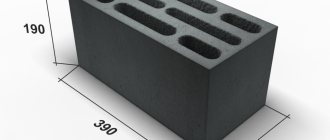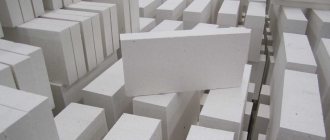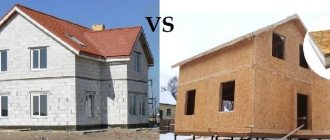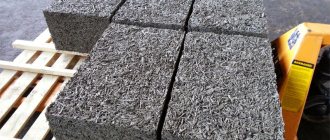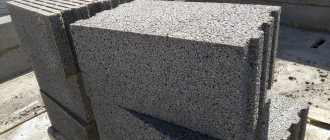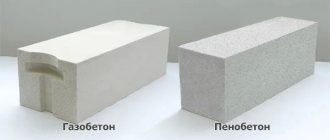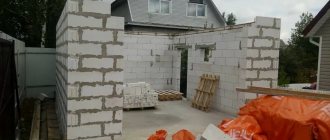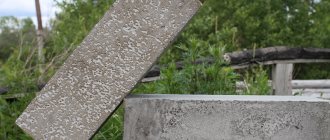When thinking about whether to choose aerated concrete or ceramic blocks for building a house, which is better for the implementation of the project and how to ensure maximum performance for the future structure, you need to consider both materials separately and in comparison. Both options are popular and guarantee a high level of strength and reliability of the building, but each has its own characteristics, which need to be studied before making a choice.
Characteristics of ceramic blocks
Ceramic block is a type of large-format brick. The material is made from low-melting clay. Due to its high strength, it can be used for the construction of both private housing construction projects and buildings up to 9 floors high. A distinctive feature of the material is the presence of voids in the structure.
A ceramic block is produced from clay and special porous agents (straw, rice husks, sawdust, peat can be used) by molding and firing. Herbal additives in the composition occupy about 50%; after they burn out at high temperatures (about +1000 degrees), empty holes remain in the block for several hours.
Due to the need to use complex equipment, the risk of buying a handicraft product is minimal. The material is supplied by large factories; the price may vary depending on the material for the voids (the most expensive ones are filled with polyurethane foam or basalt fiber).
Analysis of the main characteristics
Ceramic blocks are very strong and durable, available in 14 main sizes, exceeding the size of ordinary brick by 2-15 times. Each block is made with vertical tongues and grooves, which guarantees a tight fit between adjacent masonry elements.
Standard dimensions of ceramic block:
- Length – 35, 38, 39.8 and 51 centimeters
- Width – 18, 25 and 25.5 centimeters
- Thickness – 140, 188 and 219 millimeters
Each module has its own designation, calculated in comparison with the volume of a regular brick. The change is based on a single block with dimensions of 25x12x6.5 centimeters - this is 1NF. Thus, large-format blocks can be made in sizes 14.3NF - 51x25x21.9 centimeters. The number represents the number of regular sized bricks that can be replaced by one block.
By purpose the blocks are:
- Facial - with a textured or smooth surface, can be colored.
- Ordinary - with a corrugated or smooth surface, made from clay with a minimum amount of modified additives.
Also, blocks can be hollow or solid. The voids in them are usually end-to-end, of different geometries. For ease of grip, square/rectangular holes can be provided.
Main technical characteristics of ceramic block:
- Thermal conductivity – around 0.13-0.28 W/m*K
- Service life – from 50 years
- Water absorption – 10-15%
- Frost resistance – from F50
- Strength grade – M75
- Sound insulation – 53.5 dB
- Void – 50%
- Density – 750-850 kg/m3
Advantages and disadvantages of the material
When thinking about choosing a ceramic block or aerated concrete for construction, you need to carefully study the pros and cons of both materials, as well as determine the key requirements for the project.
The main advantages of ceramic blocks:
- Strength – the material is able to withstand considerable mechanical loads and is not afraid of negative influences.
- Simple and quick installation - thanks to the large size of the ceramic blocks.
- Relatively light weight - the load on the foundation is reduced, making it easier to work.
- Saving on masonry mortar is due to the presence of a tongue-and-groove joint that does not need to be filled.
- Long service life.
- Good sound insulation characteristics - due to the presence of voids in the structure, the material absorbs sound well; interior partitions are often built from it.
- Thermal insulation is within the range of 0.18-0.22 W/m - to create a warm house, it is enough to lay external walls with a thickness of 40 centimeters.
- Environmentally friendly and safe for life and human health - no harmful substances in the composition, elimination of toxic fumes, etc.
- Fire resistance - the material does not support the combustion process.
- Resistance to moisture, which makes the product able to withstand precipitation and guarantee the absence of mold and mildew.
- Good vapor permeability - humidity and microclimate in the room are regulated naturally.
Some disadvantages of ceramic blocks:
- High cost - so, if you choose blocks with a density of up to 900 kg/m3, for optimal thermal conductivity you will have to lay walls with a thickness of 70 centimeters. When choosing blocks with a density of about 750 kg/m3, the walls can be made thinner, but the material is also more expensive.
- Non-ideal geometry - blocks can differ in height, for example, up to 4 millimeters, which increases the number of cold bridges and the consumption of masonry mortar.
- Difficulty in processing - the blocks are poorly grooved and drilled; when working with them, you can only use electric, reciprocating, pendulum saws, which do not provide high accuracy.
- The fragility of the blocks means that they must be loaded/unloaded and transported very carefully.
About the production of ceramic blocks
With its predecessors - classic red and hollow bricks, the ceramic block has a certain similarity, both in terms of raw materials and some operational characteristics. At the same time, the production process is more technologically advanced, which does not have a positive effect on the final cost, but is compensated by the quality of the product. Ceramic blocks receive their usual appearance at the end of the following technological chain:
- Preparation of raw materials. Clay is mixed with porosizers - additives that reduce density and set the thermal parameters of products. Additives can include crushed sawdust, cereal husks, waste paper or polystyrene. The mixture is passed through clay grinding machines (which makes it homogeneous), and through a press, which removes excess water.
- Molding. The prepared clay mass in the form of a beam is pressed through a high-strength mold (die), forming the outer surfaces and voids of future blocks.
- Drying and firing. The clay beam is cut into individual products and dried in a special chamber; the process takes from two to three days. Subsequent firing is carried out in a tunnel kiln, it lasts 40-50 hours, at 1000°C. At this temperature, the clay turns into ceramics, and the porous substances burn out, forming internal pores.
Advantages and disadvantages
When thinking about what is better - ceramics or aerated block, you need to take into account the features of the project first. After all, what is an advantage in one case may be a disadvantage in another. If we briefly consider the main pros and cons of materials, the list will look like this.
Aerated concrete as a building material:
- Advantages: light weight, large dimensions, ideal geometry, easy and quick installation (which you can do yourself), good heat saving and fire resistance, normal level of frost resistance, wide range in terms of sizes and properties.
- Disadvantages: strong water absorption, fragility of the material, certain requirements for foundation and finishing.
Ceramic block as a building material:
- Advantages
: high strength, excellent sound/heat insulation, relatively light weight, many size options, minimal water absorption, frost/moisture resistance, fire resistance.
- Flaws
: quite high cost, difficulty in processing, non-ideal geometry.
Advantages of building with warm ceramics
- The main advantage of ceramic blocks in construction is that such houses are warm. Even in our climatic conditions, they do not need to be additionally insulated, as we said above. This means you will be able to save on heating costs in your future home.
- As in the case of foam blocks and gas blocks, large sizes can greatly speed up construction. Agree, it will be possible to lay one ceramic block 14 times faster than 14 bricks. Of course, such acceleration is a utopia, but a house made of ceramic block is built approximately two and a half times faster than one made from ordinary standard brick.
- Since warm ceramics are much lighter than brick, they do not require a high-strength foundation - this is another, and very significant, factor in saving money.
- Low fire hazard. Just try burning a brick and you will understand what we are talking about.
- Houses made of ceramic blocks have a good microclimate, because such walls “breathe” due to the presence of air voids.
- A house made of such material will be much cheaper than a brick one.
Walls made of warm ceramics do not hold standard dowels. Photo youtube.com
Differences between ceramic blocks and aerated concrete
By considering the main characteristics of both materials, it is possible to comprehensively analyze their strengths and weaknesses.
Comparison of aerated concrete and ceramic blocks:
- Speed and ease of installation
– both types of blocks are large and light in weight, but ceramics are much more difficult to process. There is a difference in reinforcement: aerated concrete loses strength over time, so it requires reinforcement every 3 rows and additional reinforcement in walls longer than 6 meters, in door/window openings, etc. The ceramic block may not be reinforced even if there are a large number of floors.
- Thermal conductivity
– at the height of both aerated concrete and ceramics, but the latter is slightly lower due to its higher density.
- Strength
– ceramic blocks are denser and more durable, but aerated concrete can show different indicators (depending on grade D). Thus, aerated concrete comes in grades M35-M50, ceramic blocks - M75-M150. The indicator means that each square meter can withstand 35-50 and 75-150 kilograms, respectively. Compressive strength of materials: 1-5 MPa for aerated concrete and 10-15 MPa for ceramic block.
- Wall thickness
– provided that the same thermal conductivity is achieved, the wall made of ceramic block will be thicker.
- Block geometry
– for aerated concrete, the deviations are 1-2 millimeters and masonry can be done using adhesive compounds; for ceramic blocks, the deviation can reach up to 8 millimeters and a seam up to 10 millimeters thick is needed.
- Subsequent finishing
– aerated concrete requires mandatory interior/exterior finishing using special materials to protect it from water. The facing ceramic block may not be treated on the outside, but on the inside for aesthetics.
- Water absorption
– the indicator is much higher for aerated concrete, since it is more porous and the pores are open. Ceramics are not so susceptible to moisture.
- Shrinkage
– aerated concrete is more susceptible than ceramic block (although the coefficient is small).
- Compound
– good for both materials: ceramics are made from clay with additives, aerated concrete is made from concrete, both are environmentally friendly and safe for humans.
- Scope of application and popularity
– both types of blocks are used for the construction of internal and external walls. But ceramic block can also be used for cladding without subsequent finishing.
- Price
– aerated concrete costs much less.
Why do porous ceramics need external cladding?
The stronger the ceramic block, the fewer voids it contains - and therefore, the higher the thermal conductivity. And therefore, in order not to lose heat, such walls need to be lined with heat-insulating material. Adverse weather factors could also affect the masonry, so it must be protected with cladding.
Experts provide a diagram of a standard “sandwich”, which is often used in the construction of houses made of warm ceramics. First, you need to build a wall on it from a durable ceramic block. Then a thermal insulation layer is made (its thickness should be approximately 20-30% of the total wall thickness). On top there is an external cladding made of low-porous brick (half a brick). Such a wall will have both decent thermal conductivity and strength. And if it is assembled according to all the rules, then additional insulation will no longer be needed. Next, your home will only need cladding to give it the appearance you choose (for example, a stucco façade).
Builders recommend
In view of all the listed characteristics, the opinion of experts is this: you should choose between aerated concrete or ceramic blocks based on the design requirements of the building and only after an individual calculation.
Both materials demonstrate excellent heat conservation and resistance to various factors, and provide simple and quick wall laying.
To a large extent, it depends on the characteristics of the structure what will be more profitable: for example, when building a 3-4-storey house from expensive ceramic block, you can offset the costs by eliminating the need for reinforcement of every 2-3 rows of masonry (which is required by aerated concrete) and by not having to do the exterior finishing of the building. On the other hand, if you need to build a one-story building and want to do the finishing anyway, you should think about a cheaper gas block.
Features of laying walls made of warm ceramics: how to avoid mistakes
Everyone wants their own home to be reliable, comfortable and durable. Therefore, when choosing this or that building material, most owners are guided by operating parameters. But in order to achieve such an important goal as quality housing, it is necessary to take into account not only the performance qualities of the material, but also the manufacturability of its use. The characteristics of the future home largely depend on the masonry technology. Walls made of thermal blocks comply with the parameters declared by the manufacturer only if the masonry instructions are followed. The main construction errors include the following construction techniques:
- Attracting experienced builders. Manufacturers issue instructions for their products that explain the installation technology. It provides the main options for technical solutions (combination with the base and ceilings, erection of a wall structure, laying corners). To work with heat blocks, qualified masons with relevant work experience and familiar with this technology and instructions should be invited.
- Using traditional cement mortar. The blocks are laid not only using the proprietary warm mixture recommended by the manufacturer; The use of cement mortar is not excluded. Such a replacement is considered by some to be unequal, since cement joints have higher thermal conductivity and can significantly reduce the thermal efficiency of the building.
- Filling vertical joints. According to the technology, joints up to 5 mm wide are not filled with mortar. But, if the width exceeds the standard value, or there is a defect in the block (a ridge is missing), filling is required.
- Tool replacement. To cut ceramic blocks, you need a specialized cutting tool. The result of using a handy tool will be an uneven edge, which can only be compensated by increasing the thickness of the masonry mortar and the thermal conductivity of this section of the wall.
What to choose for construction - brick or ceramic block?
What to choose for construction - brick or ceramic block? To construct any building, it must have at least four walls. Making a choice nowadays is quite difficult, because there are so many types of building materials - from many types of wood to ultra-modern blocks. This article will compare materials such as ceramic block and brick. In order to choose the right material, you need to study the characteristics, price, and advantages in detail. First, let's look at brick
. This is a stone material that undergoes processing, consisting of baked clay, cement, etc. It comes in two varieties: the so-called silicate and ceramic. They differ in moisture resistance, temperature stability and price. Besides them, there are several more subspecies, but they all differ only in external qualities.
Until the second half of the 19th century, the production of clay bricks was manual. The bricks were molded into rectangles by hand using molds; the possibility of drying the molded bricks was only in the summer; firing took place in temporary floor ovens. In the mid-19th century, the ring kiln was invented and subsequently widely used, which revolutionized production technology. At the end of the 19th century, special drying machines also appeared that made it possible to create bricks all year round. Almost at the same time, clay-processing machines and tools appeared. In the 21st century, approximately 80% of brick production is year-round, and some large automated production plants have increased production to over 200 million units per year.
According to some experts in this field, brick construction has gained popularity due to centuries of experience rather than quality. The characteristics of this material are outlined below:
— good resistance to external factors; — sound insulation; — environmental safety; — brick walls are very durable.
Brick has the following disadvantages.
1) Brick walls absorb moisture very well, which can cause dampness to form.
2) Brick is a rather heavy material for construction.
3) It is also quite expensive material.
In many European countries, when deciding what material to build the walls of a house from, they choose the so-called ceramic block. It is environmentally friendly, a multi-story house can be built from it, and it will last for more than 150 years! Ceramic blocks are joined using a tongue-and-groove connection. Advantages of ceramic block
— There is no need to use the solution in vertical joints, which allows it to be used more rationally. - Cold resistance. — Good sound insulation, heat resistance. — When a house made of ceramic block is used for more than 150 years, it does not lose its thermal characteristics.
Ceramic block, oddly enough, also has disadvantages.
— Quite a high price.
— Finding a craftsman to build ceramic block walls is quite difficult (especially in Russia), because the material is new.
— This material is very fragile.
So, we compared these two building materials, both have both advantages and disadvantages, and it’s up to you to decide what to choose - traditional brick or modern ceramic block!
Masonry technology: step-by-step order of operations
After the foundation slab is finally concreted, its surface should be carefully marked using cords for the main alignment axes, walls and corners. Having done this, you can begin the actual laying.
Fundamentally, this process boils down to the following points:
Table of strength limits of ceramic block.
- A house made of ceramic blocks is built strictly along horizontal and vertical levels. Therefore, before starting work, a leveling mortar layer is laid at the location of the first, base, row of mounting stones. Having thus created an ideal horizontal surface, it is then carefully covered with roll waterproofing.
- Before installing the blocks, the cement mortar is laid out in a row over the entire thickness of the wall. Voids are not allowed. To prevent the blocks from being unnecessarily immersed in the soft solution, a thin layer of cement powder can be poured onto its surface, which forms a load-bearing film.
- The laying of each next row begins from the corner of the house and always from whole blocks. Each time the corner must be raised by 3-4 rows of blocks.
- When a house is built from ceramic blocks, the mortar is used exclusively to form a seam in the horizontal plane. Before installing the next row of blocks, the layer of mortar must be covered with a plastic reinforcing mesh to prevent the mortar from falling into the block voids. The stone itself must be pre-moistened with water.
- Tight joining between adjacent blocks is ensured by the tongue/groove technological connection. Experienced masons do this by guiding the next block while still in weight and lowering it onto the mortar exactly butted against the already installed block.
- The adjustment of the stones horizontally is done using light blows of a mallet (rubber hammer).
When planning these operations, we must remember that it is impossible to do without some experience in carrying out stone work. Therefore, if it is not enough, it is better to contact specialists.
JSC "BIOTECH", Volgograd
The company belonging to the industrial holding "BIS" has production facilities (Volgograd and the village of Svetly Yar). The products manufactured under the general name “Stalingrad Stone” have the following names and technical characteristics:
- THERMOBLOCK 20 (9.0NF), size – 400x200x188mm, weight – 15.5 kg.
- THERMOBLOCK 25 (9.3NF), size – 250x380x219mm, weight – 17.5 kg. Groove-ridge - on the short side, 250mm.
- THERMOBLOCK 38 (9.3NF), size – 380x250x219mm, weight – 17.5 kg. Groove-ridge – along the long side, 380mm.
- THERMOBLOCK 44 (12.4NF), size – 440x250x219mm, weight – 19.5 kg.
Main quality features
- Aerated concrete and ceramic blocks can be used both for the construction of internal walls and partitions, and for the construction of external ones.
- Unlike similar building materials, these two have a minimal number of defective products.
- In the process of work, there is a significant saving in consumables.
- Both materials have an ideal geometric shape.
- The products have a special cellular structure, as a result of which the pressure on the base is less than that of other construction products.
- Special tongue-and-groove system.
- Smooth surface of the constructed walls.
- High productivity due to the size of the materials.
Arguments for"
Low cost
To make this obvious, we present the comparative cost of 1 m3 of masonry (in rubles) of some materials:
- expanded clay concrete – 2,250;
- foam concrete – 2,650;
- brick – from 5,500.
Although these are indicative prices, they give a general idea.
The versatility of masonry
It is understood that you can use either a traditional cement-based mortar or a (special) adhesive composition. While, for example, gas silicate blocks are held together only with special glue.
Simple technology
Firstly, this is explained by the identical (if the products are not “handicraft” made) dimensions of the blocks.
Secondly, the relatively small mass of the products makes it possible to do without lifting mechanisms. For example, a “standard” solid wall block weighs about 25 kg (390 x 190 x 188). Slotted, septal - and even less. Read more about the production process and the necessary equipment for expanded clay concrete blocks.
The structure of the blocks allows the walls to “breathe”
This is due to the sufficient vapor permeability of the material. Consequently, the microclimate in the house will be maintained at a constant level with a minimum of additional costs.
Good performance
Yes, expanded clay blocks are characterized by frost and moisture resistance; they “keep” heat in the house. There are also a number of other attractive options. But if you look at reviews of other building materials, they say almost the same thing. Probably, it’s all about the correct selection of products in relation to the climate (critical temperatures, humidity, and so on).
